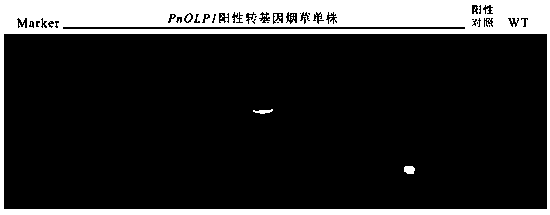Panax notoginseng reverse osmosis protein gene PnOLP1 and application
A technology of reverse osmosis and protein, applied in the fields of application, genetic engineering, plant genetic improvement, etc., can solve problems such as the long growth cycle of Panax notoginseng, excessive pesticide residues and heavy metal content in medicinal materials of Panax notoginseng, and the impact on the quality of medicinal materials in Panax notoginseng production, etc., to achieve Broad market application prospects, shortened breeding cycle, and cost-saving effects
- Summary
- Abstract
- Description
- Claims
- Application Information
AI Technical Summary
Benefits of technology
Problems solved by technology
Method used
Image
Examples
Embodiment 1
[0019] Example 1: PnOLP1 Full-length gene cloning and sequence analysis
[0020] The roots of Panax notoginseng were inoculated with Fusarium solani rot, total RNA was extracted from the roots 12 h after inoculation, the treated roots of Panax notoginseng were ground into powder with liquid nitrogen, and then transferred to a centrifuge tube, and guanidine isothiocyanate was used to Total RNA was extracted using the method; M-MLV reverse transcriptase (promega) was used to synthesize the first strand of cDNA using total RNA as a template. The reaction system and operation process were as follows: take 5 μg Total RNA, add 50 ng oligo (dT), 2 μL dNTP in sequence Mix (2.5 mM each), make up the reaction volume to 14.5 μL with DEPC water; after mixing, heat and denature at 70°C for 5 min, then quickly cool on ice for 5 min, then add 4 μL 5×First-stand buffer, 0.5 μL RNasin (200U), 1 μL M-MLV (200U), mix well and centrifuge briefly, incubate at 42°C for 1.5 h, take it out and heat at
Embodiment 2
[0023] Embodiment 2: plant overexpression vector construction
[0024] Use the SanPrep column plasmid DNA mini-extraction kit (Shanghai Sangong) to extract the insert PnOLP1 coli plasmid pGEM-T- PnOLP1 As well as the plasmid of the plant expression vector pCAMBIA2300S, take 1 μL for agarose gel electrophoresis to detect the integrity and concentration of the extracted plasmid; Bam HI and Eco RI respectively for plasmid pGEM-T- PnOLP1 and pCAMBIA2300S for double enzyme digestion (100 μL system), the reaction system and operation process are as follows: take 20 μL pGEM-T- PnOLP1 and pCAMBIA2300S plasmid, add 10μL 10×H buffer, 5μL Eco RI, 5 μL Bam HI, 60 μL ddH 2 O, after mixing, centrifuge for a short time, and place it at 37°C for overnight reaction; perform agarose gel electrophoresis on all digested products, and then use the kit to analyze PnOLP1 The fragments and the large fragments of the pCAMBIA2300S vector were gel-recovered separately, and 1 μL of the recovered
Embodiment 3
[0027] Example 3: Plant genetic transformation mediated by Agrobacterium and screening of transgenic plants
[0028] The transgenic recipient in this experiment was tobacco ( Nicotiana tabacum ), the tobacco seeds were soaked in 75% alcohol for 30s, washed with sterile water and washed with 0.1% HgCl 2 Soak for 8 minutes, then wash several times with sterile water, sow on 1 / 2 MS medium, culture in dark at 28°C for 5-8d, transfer to light incubator after germination (25°C, 16h / d light), and then Subculture once a month with MS medium.
[0029] Take out the pCAMBIA2300s- containing pCAMBIA2300s-PnOLP1 Agrobacterium LBA4404 strain of the plasmid was inoculated in 5 mL of LB liquid medium containing 50 mg / L Km and 20 mg / L rifampin in 20 μL, and cultured at 28°C until the medium was turbid. Pipette 1 mL of turbid bacterial solution onto LB solid medium containing 50 mg / L Km, and incubate at 28°C for 48 h; then scrape off the Agrobacterium on LB solid medium and inoculate
PUM
 Login to view more
Login to view more Abstract
Description
Claims
Application Information
 Login to view more
Login to view more - R&D Engineer
- R&D Manager
- IP Professional
- Industry Leading Data Capabilities
- Powerful AI technology
- Patent DNA Extraction
Browse by: Latest US Patents, China's latest patents, Technical Efficacy Thesaurus, Application Domain, Technology Topic.
© 2024 PatSnap. All rights reserved.Legal|Privacy policy|Modern Slavery Act Transparency Statement|Sitemap



